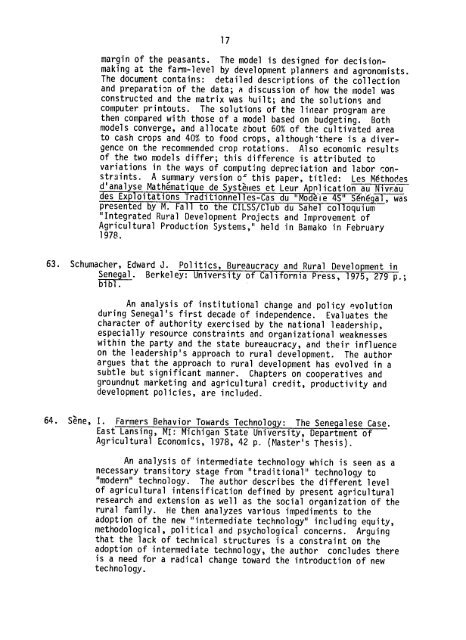SO 0\C)V'lQ " -- - usaid/ofda
SO 0\C)V'lQ " -- - usaid/ofda
SO 0\C)V'lQ " -- - usaid/ofda
Create successful ePaper yourself
Turn your PDF publications into a flip-book with our unique Google optimized e-Paper software.
17<br />
margin of the peasants. The model is designed for decisionmaking<br />
at the farm-level by development planners and agronomists.<br />
The document contains: detailed descriptions of the collection<br />
and preparation of the data; a discussion of how the model was<br />
constructed and the matrix was built; and the solutions and<br />
computer printouts. The solutions of the linear program are<br />
then compared with those of a model based on budgeting. Both<br />
models converge, and allocate about 60% of the cultivated area<br />
to cash crops and 40% to food crops, although'there is a divergence<br />
on the recommended crop rotations. Also economic results<br />
of the two models differ; this difference is attributed to<br />
variations in the ways of computing depreciation and labor constraints.<br />
A summary version oc this paper, titled: Les Mfthodes<br />
d'analyse Math6matique de Syst'emes et Leur Application au Nivwau<br />
des Exploitations Traditionnelles-Cas du "ModRe 4S" S~n~g, was<br />
presented by M. Fall to the CILSS/Club du Sahel colloquium<br />
"Integrated Rural Development Projects and Improvement of<br />
Agricultural Production Systems," held in Bamako in February<br />
1978.<br />
63. Schumacher, Edward J. Politics, Bureaucracy and Rural Development in<br />
Senegal. Berkeley: University of California Press, 1975, 279 p.;<br />
bibl.<br />
An analysis of institutional change and policy evolution<br />
during Senegal's first decade of independence. Evaluates the<br />
character of authority exercised by the national leadership,<br />
especially resource constraints and organizational weaknesses<br />
within the party and the state bureaucracy, and their influence<br />
on the leadership's approach to rural development. The author<br />
argues that the approach to rural development has evolved in a<br />
subtle but significant manner. Chapters on cooperatives and<br />
groundnut marketing and agricultural credit, productivity and<br />
development policies, are included.<br />
64. Sene, I. Farmers Behavior Towards Technology: The Senegalese Case.<br />
East Lansing, MI: Michigan State University, Department of<br />
Agricultural Economics, 1978, 42 p. (Master's Thesis).<br />
An analysis of intermediate technology which is seen as a<br />
necessary transitory stage from "traditional" technology to<br />
"modern" technology. The author describes the different level<br />
of agricultural intensification defined by present agricultural<br />
research and extension as well as the social organization of the<br />
rural family. He then analyzes various impediments to the<br />
adoption of the new "intermediate technology" including equity,<br />
methodological, political and psychological concerns. Arguing<br />
that the lack of technical structures is a constraint on the<br />
adoption of intermediate technology, the author concludes there<br />
is a need for a radical change toward the introduction of new<br />
technology.

















